Indigenous
There are no Indian Residential School denialists, so why criminalize them?

From the Frontier Centre for Public Policy
By Rodney A. Clifton, professor emeritus at the University of Manitoba and a senior fellow at the Frontier Centre for Public Policy. (He was a former Senior Boys’ Supervisor in Stringer Hall, the Anglican residence in Inuvik.)
” both sides agree that Indian Residential Schools existed, and that some children were harmed. But they disagree on the evidence needed to prove whether children were murdered and buried unceremoniously in residential schoolyards. “
In a recent Canadian Press story, Kimberly Murray, the government’s special interlocutor on unmarked graves of missing Indigenous children from residential schools, is reported as saying: “We could … make it an offense to incite hate and promote hate against Indigenous people by … denying that residential (schools) happened or downplaying what happened in the institutions.” Not surprisingly, the Liberal government of Prime Minister Justin Trudeau is sympathetic to the special interlocutor’s call to action.
Ms. Murray says that Indigenous leaders across the country support her call for legislation. The Assembly of Manitoba Chiefs (AMC), for example, asked the Justice Minister, Arif Virani, to amend the criminal code to criminalize denialism. AMC Grand Chief Cathy Merrick said that enacting such a law would provide “an opportunity for Canada to demonstrate an honest commitment to reconciliation…. to deny the existence of these institutions is a form of violence.”
The focus on missing and murdered Indigenous children at residential schools became a national disgrace at the end of May 2021 when the Kamloops First Nation announced that stories from Knowledge Keepers and evidence from ground-penetrating radar (GPR) had “discovered” the graves of 215 children in the schoolyard of the Kamloops Indian Residential School.
Since that announcement, first nations across the country have discovered many more “graves,” also relying on Knowledge Keepers stories and GPR evidence. But so far, no bodies of IRS students have been exhumed from the schoolyards, even though the Chief TRC Commissioner, Justice Murry Sinclair, told CBC Radio host Matt Galloway a couple of years ago that as many as 15,000 to 25,000 Indian Residential School students are missing.
Surprisingly, these claims are not included in the Truth and Reconciliation Commission (TRC) Report. In fact, only one story of a murdered child is reported in the TRC Report, and it is the unverified story told by Doris Young about seeing a child’s murder at the Anglican Elkhorn Indian Residential School in Manitoba. The Commission reported this alleged murder but did not investigate the claim. Indeed, the Commission spent $60 million over six years and did not report any evidence, other than the Doris Young’s claim, of the murder of Indigenous children at residential schools.
What does this mean for criminalizing denialism?
There are at least three problems with potential legislation to criminalize denialism. First, Canada already has legislation on hate speech, and so new legislation is unnecessary.
Second, the definition of “denialism,” as reported above, is so vague that it would be almost impossible to convict anyone.
Finally, and most importantly, from what can be gathered from both Ms. Murray’s interim report and recent news items, practically no Canadians deny that Indian Residential Schools existed or that some children were harmed at those schools.
What Canadians seem to disagree on is the evidence that is needed to prove that IRS students were murdered, and their bodies were unceremoniously buried in unmarked graves in residential schoolyards.
On Ms. Murray’s side, supporters’ reason that “hear-say” evidence from Indigenous Knowledge Keepers and shadows on GPR screens are adequate to prove the claim. On the other side, the so-called “deniers” reason that forensic evidence from exhumed bodies is needed.
So, both sides agree that Indian Residential Schools existed, and that some children were harmed. But they disagree on the evidence needed to prove whether children were murdered and buried unceremoniously in residential schoolyards.
The Canadian law enforcement and justice system is the proper agency for an impartial investigation of this claim, and if evidence is obtained, to criminally charge those Indigenous and non-Indigenous IRS employees responsible and to report their names and crimes if they are deceased.
Surely Canadians would support such an impartial investigation leading to possible criminal charges. Till that happens, there is no reason to demonize the so-called “deniers” by those who disagree with the evidence they think is necessary to answer this important question. Without an independent investigation along with a public report, Canada cannot reach a fair and just reconciliation between Indigenous and non-Indigenous Canadians.
Indeed, many people are wondering why such a rigorous, systematic, investigation has not yet been conducted. It is the time to settle this issue so that both sides—indeed all Canadians—can move on from being pitted against each other over an issue that can be easily resolved with an independent investigation by competent justice officials.
Rodney A. Clifton is a is a professor emeritus at the University of Manitoba and a senior fellow at the Frontier Centre for Public Policy. He lived for four months in Old Sun, the Anglican Residential School on the Blackfoot (Siksika) First Nation, and was the Senior Boys’ Supervisor in Stringer Hall, the Anglican residence in Inuvik. Rodney Clifton and Mard DeWolf are the editors of From Truth Comes Reconciliation: An Assessment of the Truth and Reconciliation Commission Report (Frontier Centre for Public Policy, 2021). A second and expanded edition of this book will be published in 2024.
Energy
Indigenous-led Projects Hold Key To Canada’s Energy Future

From the Frontier Centre for Public Policy
Indigenous leaders call for policy reforms and Indigenous equity ownership to unlock Canada’s energy potential
A surprising twist in Canada’s pipeline debate emerged on Jan. 21, 2025, when Alberta Premier Danielle Smith called for a revival of the Northern Gateway pipeline.
Unexpectedly, Grand Chief Stewart Phillip, president of the Union of B.C. Indian Chiefs, voiced support, warning that if Canada doesn’t act, Donald Trump will. Yet just a day later, Phillip abruptly retracted his statement, raising fresh questions about external influence and the future of Indigenous participation in energy development.
Northern Gateway, a pipeline once proposed to carry Alberta oilsands crude to the B.C. coast for export to Asia, was cancelled in 2016 after years of environmental opposition and legal challenges. Its demise became a symbol of Canada’s broader struggles to balance resource development, environmental concerns and Indigenous rights. Now, amid rising global energy demand and growing Indigenous interest in ownership stakes, calls to revive the project are resurfacing, with political, legal and economic implications.
Adding to the intrigue, Phillip has long been a vocal critic of major resource projects, including Northern Gateway, making his initial endorsement all the more surprising.
Some observers, like Calvin Helin, a member of the Tsimshian Nation and principal at INDsight Advisers, see deeper forces at work. A lawyer specializing in commercial and Indigenous law and a best-selling author, Helin believes the incident highlights how environmental activists are shaping the conversation.
“Environmental groups have infiltrated some Indigenous organizations,” Helin said in an interview. “They managed to support a government that championed their agendas, particularly Alberta-focused objectives like the coastal pipeline ban and changes to the regulatory approval system. In this era of Trump, all they’ve managed to do is weaken Canada’s position.”
Nonetheless, Helin emphasized that the energy industry has learned the importance of genuine engagement with Indigenous interests. He pointed out that Indigenous leaders increasingly support responsible natural resource development. Inclusion and recognition from the outset, Helin argued, are essential for energy projects in 2025 and beyond.
After the cancellation of Northern Gateway, Indigenous leader Dale Swampy, who helped establish the Northern Gateway Aboriginal Equity Partners, formed the National Coalition of Chiefs, a pro-development alliance of First Nation chiefs advocating for oil and gas development in their communities.
Swampy continues to champion the idea of a pipeline dedicated solely to moving bitumen to the coast, arguing that Canada has been “putting all its eggs in one basket” by selling almost exclusively to the United States while competitors, including the U.S. itself, have entered global markets.
According to the Canadian Energy Centre, global demand for oil and gas in emerging and developing economies is expected to remain robust through 2050. With the added pressures of U.S. tariffs, conversations about Canadian pipelines to tidewater have gained urgency. Swampy advocates for a policy reset and the revival of Northern Gateway, this time powered by Indigenous equity investment.
“First, we’ve got to get rid of the oil tanker ban (Bill C-48),” Swampy said. “We need more fluid regulatory processes so we can build projects on a reasonable timeline, without costing us billions more waiting for approvals—like TMX (Trans Mountain Expansion Project). And you’ve got to get the proponents back to the table. Last time, 31 of the 40 communities were already signed on. I believe we can get them on board again.”
Swampy continues to work with industry partners to develop an Indigenous-led bitumen pipeline to the West Coast. “We can get this project built if it’s led by First Nations.”
He also noted that other Indigenous leaders are increasingly recognizing the benefits of collaborating on resource development, whether in mining or B.C. LNG projects, which he says enjoy widespread First Nations support.
Discussions with Helin, Swampy and other Indigenous leaders resulted in the following policy recommendations for 2025 and beyond.
- Repeal Bill C-69, the Impact Assessment Act. It blocks not only pipelines but also mines, refineries, export plants and other energy infrastructure in which First Nations want to invest. The Supreme Court of Canada ruled it unconstitutional on Oct. 13, 2023.
- Cut taxes to offset U.S. tariffs. Reducing taxes on investment and energy projects can neutralize tariff impacts and attract new investment. Eliminate the carbon tax, which Indigenous leaders argue has placed Canada at a strategic disadvantage globally.
- Repeal Bill C-59, the so-called greenwashing bill. According to Stephen Buffalo, president and chief executive officer of the Indian Resource Council of Canada, this legislation has silenced many voices within the Indigenous energy community.
- Approve LNG plants and related infrastructure. Canada currently sells gas exports almost exclusively to the United States, but there’s a strong business case for expanding to Asian and European markets. In a recent Canadian Energy Ventures webcast, it was revealed that LNG sold to Europe fetches up to 16 times the price Canada receives from U.S. sales. First Nations are already successfully involved in Woodfibre LNG, Cedar LNG and Ksi Lisims LNG in B.C.
- Cut regulatory delays. Prolonged approval timelines erode investor confidence. Streamlining processes can help projects proceed in reasonable timeframes.
Finally, clarify reconciliation guidelines. Clearly define what constitutes meaningful consultation. Industry must treat Indigenous peoples as true partners, advancing economic reconciliation through equity partnerships.
A social media stir over Northern Gateway has reignited debate over Indigenous ownership in Canada’s energy future. While some leaders waver, others like Helin and Swampy make a compelling case: Indigenous-led projects are crucial for Canada’s economic and energy security. Their message is clear — repeal restrictive policies, accelerate project approvals and embrace Indigenous equity. If Ottawa removes the roadblocks, Canada can unlock its full energy potential.
Maureen McCall is an energy business analyst and Fellow at the Frontier Center for Public Policy. She writes on energy issues for EnergyNow and the BOE Report. She has 20 years of experience as a business analyst for national and international energy companies in Canada.
Canadian Energy Centre
First Nations in Manitoba pushing for LNG exports from Hudson’s Bay

From the Canadian Energy Centre
By Will Gibson
NeeStaNan project would use port location selected by Canadian government more than 100 years ago
Building a port on Hudson’s Bay to ship natural resources harvested across Western Canada to the world has been a long-held dream of Canadian politicians, starting with Sir Wilfred Laurier.
Since 1931, a small deepwater port has operated at Churchill, Manitoba, primarily shipping grain but more recently expanding handling of critical minerals and fertilizers.
A group of 11 First Nations in Manitoba plans to build an additional industrial terminal nearby at Port Nelson to ship liquefied natural gas (LNG) to Europe and potash to Brazil.
Robyn Lore, a director with project backer NeeStaNan, which is Cree for “all of us,” said it makes more sense to ship Canadian LNG to Europe from an Arctic port than it does to send Canadian natural gas all the way to the U.S. Gulf Coast to be exported as LNG to the same place – which is happening today.
“There is absolutely a business case for sending our LNG directly to European markets rather than sending our natural gas down to the Gulf Coast and having them liquefy it and ship it over,” Lore said. “It’s in Canada’s interest to do this.”
Over 100 years ago, the Port Nelson location at the south end of Hudson’s Bay on the Nelson River was the first to be considered for a Canadian Arctic port.
In 1912, a Port Nelson project was selected to proceed rather than a port at Churchill, about 280 kilometres north.
The Port Nelson site was earmarked by federal government engineers as the most cost-effective location for a terminal to ship Canadian resources overseas.
Construction started but was marred by building challenges due to violent winter storms that beached supply ships and badly damaged the dredge used to deepen the waters around the port.
By 1918, the project was abandoned.
In the 1920s, Prime Minister William Lyon MacKenzie King chose Churchill as the new location for a port on Hudson’s Bay, where it was built and continues to operate today between late July and early November when it is not iced in.
Lore sees using modern technology at Port Nelson including dredging or extending a floating wharf to overcome the challenges that stopped the project from proceeding more than a century ago.
He said natural gas could travel to the terminal through a 1,000-kilometre spur line off TC Energy’s Canadian Mainline by using Manitoba Hydro’s existing right of way.
A second option proposes shipping natural gas through Pembina Pipeline’s Alliance system to Regina, where it could be liquefied and shipped by rail to Port Nelson.
The original rail bed to Port Nelson still exists, and about 150 kilometers of track would have to be laid to reach the proposed site, Lore said.
“Our vision is for a rail line that can handle 150-car trains with loads of 120 tonnes per car running at 80 kilometers per hour. That’s doable on the line from Amery to Port Nelson. It makes the economics work for shippers,” said Lore.
Port Nelson could be used around the year because saltwater ice is easier to break through using modern icebreakers than freshwater ice that impacts Churchill between November and May.
Lore, however, is quick to quell the notion NeeStaNan is competing against the existing port.
“We want our project to proceed on its merits and collaborate with other ports for greater efficiency,” he said.
“It makes sense for Manitoba, and it makes sense for Canada, even more than it did for Laurier more than 100 years ago.”
-

 2025 Federal Election1 day ago
2025 Federal Election1 day agoStudy links B.C.’s drug policies to more overdoses, but researchers urge caution
-

 Business2 days ago
Business2 days agoChinese firm unveils palm-based biometric ID payments, sparking fresh privacy concerns
-

 Environment2 days ago
Environment2 days agoExperiments to dim sunlight will soon be approved by UK government: report
-

 2025 Federal Election2 days ago
2025 Federal Election2 days agoConservatives promise to ban firing of Canadian federal workers based on COVID jab status
-

 International2 days ago
International2 days agoPope Francis Got Canadian History Wrong
-

 2025 Federal Election1 day ago
2025 Federal Election1 day agoCarney’s Hidden Climate Finance Agenda
-

 2025 Federal Election1 day ago
2025 Federal Election1 day agoWhen it comes to pipelines, Carney’s words flow both ways
-

 Business1 day ago
Business1 day agoIs Government Inflation Reporting Accurate?








